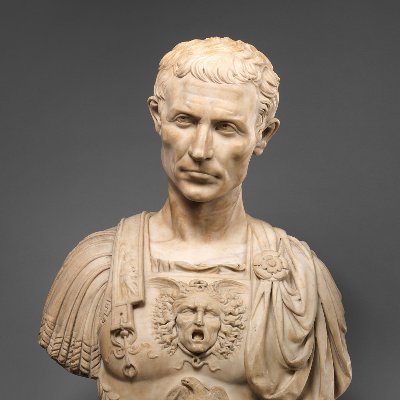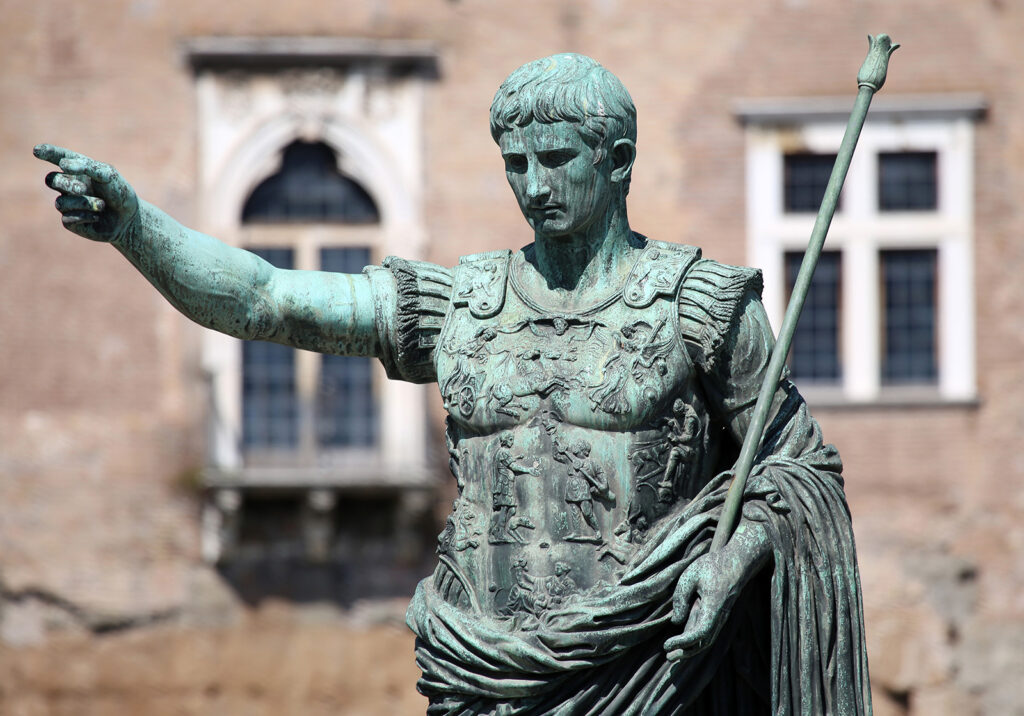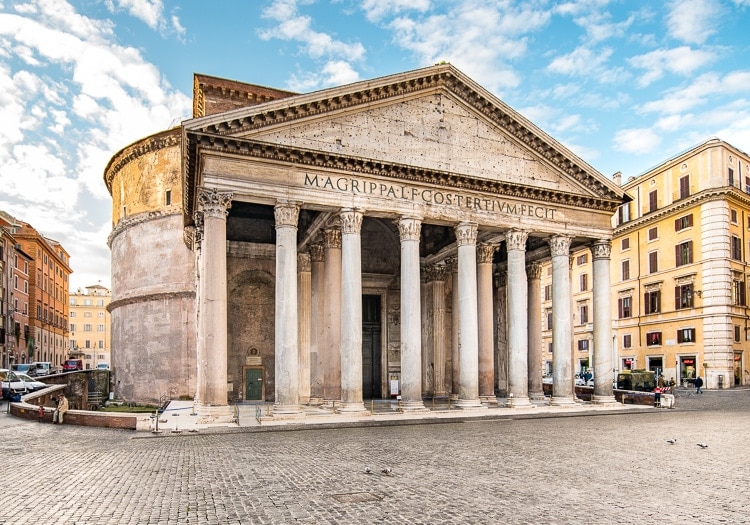ប្រវត្តិសាស្រ្តនៃអរិយធម៌រ៉ូមបុរាណ គឺទាក់ទងជាមួយនឹងការវិវត្តន៍ប្រវត្តិសាស្រ្តនយោបាយ វប្បធម៌ ដែលបានបង្ហាញពីការបែ្រប្រួលរបបនយោបាយក្នុងសង្គមរបស់ខ្លួនចាប់តាំងពីដើមស.វ.ទី១មុនគ.ស.មក ។
មុននឹងក្លាយជាអាណាចក្ររ៉ូមាំង រ៉ូមដែលជាទីក្រុងតូចមួយនៅតាមបណ្តាយទន្លេ ទិប (Tibre) ស្ថិតនៅកណ្តាលនៃប្រទេសអ៊ីតាលី។ នៅដើមស.វ.ទី១ រ៉ូមចាប់ផ្តើមពង្រីកទឹកដីវិសាលភាពរបស់ខ្លួនរហូតដល់ឈូងសមុទ្រពែក្ស ទាំងនយោបាយ កងទ័ព និងទំនៀមទម្លាប់របស់ខ្លួន ដែលក្រោយមកបានក្លាយជាអត្តសញ្ញាណវប្បធម៌លោកខាងលិច (រូបលេខ១)។
នៅក្នុងប្រវត្តិសាស្រ្តរ៉ូមបុរាណអ្នកស្រាវជ្រាវ បានបែងចែកចេញជាបីសម័យកាលធំៗ ក្នុងនោះមានដូចជា សម័យរាជានិយម ( Royal ) សម័យសារធារណៈ( Republic) និងសម័យអធិរាជរ៉ូម ( Imperial )។ ក្នុងអំឡុងពេលដែលរ៉ូមបុរាណកាន់របបរាជានិយម គឺស្ថិតនៅក្រោមការគ្រប់គ្រងរបស់សេ្តចចំនួន២អង្គ។ តាមរយៈរឿងព្រេង ស្តេចដំបូងគឺមានឈ្មោះថា Romulus និងបន្ទាប់មកទៀតគឺ ស្តេច Remus ដែលជាប្អូនបង្កើត។
តាមរយៈរឿងព្រេងនោះដែរ ទីក្រុងរ៉ូមបុរាណត្រូវបានកសាងដោយស្តេច Romulus និង Remus នៅឆ្នាំ ៧៥៣មុនគ.ស. ដែលអ្នកស្រាវជ្រាវបានប៉ាន់ស្មានថា ទីក្រុងរ៉ូមពេលនោះមានប្រជាជនរស់នៅច្រើនជាងប្រជាជនក្នុងតំបន់អ៊ីរ៉ុបនាទ.ស.ទី៩០។ នៅឆ្នាំ ៥០៩ មុនគ.ស. រ៉ូមបុរាណបានផ្លាស់ប្តូរមកកាន់របបសារធារណៈ ដោយបានធ្វើការបណ្តេញស្តេចឱ្យចុះចេញពីបល្ល័ង្គ ដោយជំនួសមកវិញនូវការបោះឆ្នោត ដោយជ្រើសរើសអ្នកដឹកនាំថ្មី ចំនួនពីរនាក់ដែលហៅថា កុងសុល (Consul)។ មេដឹកនាំ ឬកុងសុលដែលល្បីឈ្មោះជាងគេនោះ មានឈ្មោះ ថា Jules Cesar(៤៩-៤៤មុនគ.ស)។
បន្ទាប់មកទៀតគឺសម័យកាលអធិរាជរ៉ូមាំង ដែលរ៉ូមបុរាណចាប់ផ្តើមធ្វើសង្គ្រាមវៀតទីទឹកដី ហើយបានក្លាយជាអាណាចក្ររ៉ូមាំងដ៏រុងរឿង ក្រោមការដឹកនាំដោយមេដឹកនាំឈ្មោះ Octave ដែលក្រោយមកក្លាយជាអធិរាជ Auguste (២៧មុនគ.ស. ដល់១៤គ.ស.) និងអធិរាជមួយព្រះអង្គទៀតមានឈ្មោះ Nero (៥៤មុនគ.ស. ដល់៦៨គ.ស.) ដែលបានពង្រីកទឹកដី អាណាចក្ររ៉ូមឱ្យកាន់តែធំជាងមុន នៅតំបន់សមុទ្រមីឌីទែររ៉ាណេ។ នៅសម័យនោះរ៉ូម ចាប់ផ្តើមធ្វើសង្រ្គាមដណ្តើមទឹកដីលើប្រទេសជិតខាងខ្លួនដែលមានដូចជា ក្រិច អេហ៊ីប និង កាតាច (Carthage) សព្វថ្ងៃជាប្រទេសទុយនេស៊ី ។
ភាសាឡាតាំងត្រូវបានគេដឹងថា ជាភាសាផ្លូវការរបស់រ៉ូមបុរាណ ហើយស្ថិតនៅក្នុងអំបូរភាសា ឥណ្ឌូអ៊ីរ៉ុប ដែលជាមូលដ្ឋានគ្រឹះនៃភាសាមួយចំនួនបណ្តាប្រទេសក្នុងតំបន់អ៊ីរ៉ុបដូចជា បារាំង អេស្ប៉ាញ ព័រទុយកាល់ និងរមែននីជាដើម។ ចំពោះសិល្បៈ ស្ថាបត្យកម្ម រ៉ូមាំងត្រូវបានគេដឹងថា ទទួលឥទ្ឋិពលពីអរិយធម៌ក្រិចបុរាណ។ សំណង់ស្ថាបត្យកម្មក្រិចបុរាណ ជាពិសេសសំណង់សសរដែលល្បីល្បាញត្រូវបានពួករ៉ូមាំងយកមកប្រើប្រាស់ និងការវិវត្តន៍ក្នុងសិល្បៈរបស់ខ្លួន ហើយហៅថា Pantheon និង Colisee។ អំឡុងពេលនៃការគ្រប់គ្រង អាណាចក្ររ៉ូមាំងមានការរីកចម្រើនយ៉ាងខ្លាំង។ រាល់សំណង់ហេដ្ឋារចនាសម្ព័ន្ឋដូចជា សំណង់ធារាសាស្រ្ត ជាពិសេសសំណង់ស្ពានទឹក អាងទឹកសារធារណៈ ព្រះរាជាវាំង សំណង់ Forums សំណង់ Colosseum ជាដើម។ នៅប្រមាណស.វ.ទី៤នៃគ.ស អាណាចក្ររ៉ូមាំងចាប់ផ្តើមចុះខ្សោយ និងដួលរលំដែលបណ្តាលមកពីកត្តាផ្សេងៗ។ កត្តាចម្បងនោះគឺ អំពីផុករលួយក្នុងនយោបាយ សេដ្ឋកិច្ចធ្លាក់ចុះ ការមានសង្គ្រាមផ្ទៃក្នុង និងការឈ្លានពានពីអាណាចក្រជិតខាងដែលជាដើមចមនៃការដួលរលំអាណាចក្ររ៉ូមាំង។
រាល់ទន្និន័យទាំងអស់ដែលបានបង្ហាញខាងលើនេះ អាចបង្ហាញឱ្យយើងដឹងបានថា អរិយធម៌រ៉ូមត្រូវបានគេស្គាល់ថា ជាអរិយធម៌ ដែលមានឥទ្ឋិពលខ្លាំងលំដាប់ទី២បន្ទាប់អរិយធម៌ក្រិចក្នុងប្រវត្តិសាស្រ្តតំបន់អ៊ីរ៉ុប។ ការដែលសម្គាល់ថា បែបនេះ គឺតាមរយៈវិសាលភាពនៃការគ្រប់គ្រងទឹកដីស្ទើរទាំងស្រុងនៃតំបន់អ៊ីរ៉ុប និងសំណង់ស្ថាបត្យកម្មដែលបានបន្សល់ទុកជាច្រើននៅក្នុងបណ្តាប្រទេសក្នុងតំបន់អ៊ីរ៉ុប ជាពិសេសសំណង់ស្ថាបត្យកម្មបុរាណស្ថិតក្នុងរាជធានី រ៉ូមផ្ទាល់៕
—————————-
Rome Civilization
The history of ancient Roman civilization is related to the evolution of political history, and cultural history, which reflected the political changes in its society from the beginning of the first century BC.
Before becoming the Roman Empire, Rome was a small town on the river Tibre in central Italy. At the beginning of the 1st century CE, Rome began to expand its territory as far as the Persian Gulf, both politically, militarily, and by its customs, which later became a Western cultural identity.
In ancient Roman history, researchers divided it into three major periods: the Royal, the Republic, and the Imperial. During the ancient Roman monarchy was under the rule of two kings. According to the legend, the first king was named Romulus and the second Remus king is Romulus’s brother, as well ancient city of Rome was built by King Romulus and Remus in 753 BC. Based on researchers assumed that Rome was more populous than the inhabitants of Europe in 90 BC and during 509 BC the ancient Rome moved to a republic, overthrowing the emperor by electing two new leaders called the Consul.
Later is the coming of the Roman Empire, in which the ancient Romans began a war of territorial warfare and became a glorious Roman Empire under the leadership of Octave, who later became Emperor Auguste (27 BC to 14 AD) and another emperor named Nero (54 BC to 68 AD) who expanded the territory of the Roman Empire larger in the Mediterranean Sea. At that time, Rome began a war of conquest over its neighbors, Greece, Egypt, and Carthage, now Tunisia.
Latin is known as the official language of ancient Rome and belongs to the Indo-European language family, which is the basis of some languages in European countries such as French, Spanish, Portuguese, Romanian, etc. Whereas, art and architecture are known to have been influenced by ancient Greek civilization. Ancient Greek architecture, especially the famous pillars, was used by the Romans and evolved in their art, called the Pantheon and the Colisee (Figs. 6-7). During the reign of the Roman Empire, there was great progress. All infrastructure such as irrigation, especially bridges, public swimming pools, royal palaces, forums, colosseums, etc. In the 4th century AD, the Roman Empire began to weaken and collapse due to various factors. The main factors were political corruption, economic decline, civil war, and the invasion of neighboring empires, which led to the collapse of the Roman Empire.
In conclusion, Roman civilization is known as the second most influential civilization after the Greek civilization in the history of Europe. This distinction is due to the extent of territorial control of almost all of the European region and the architectural remains in many European countries, especially the ancient architecture in the Roman capital itself.
អត្ថបទដើម៖ លោក អេង តុលា










